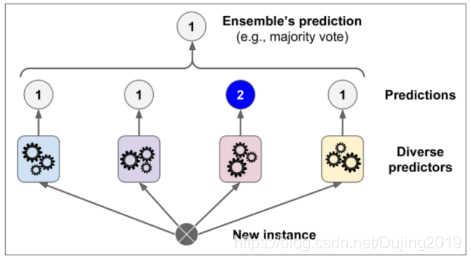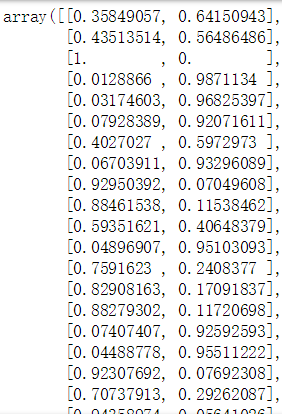机器学习——集成算法
(一)集成算法原理
集成算法:
构建多个学习器,然后通过一定策略结合把它们来完成学习任务的,常常可以获得比单一学习显著优越的学习器。
集成算法一般分为三类:Bagging,Boosting,Stacking(我们可以把它简单地看成并行,串行和树型)
1.1 Bagging模型
Bagging模型详解
Bagging的全称是bootstrap averaging,它把各个基模型的结果组织起来,具体实现也有很多种类型,以sklearn中提供的Bagging集成算法为例(下面代码中会用到部分算法):
- BaggingClassifier/BaggingRegressor是从原始数据集抽选S次(抽取实例,抽取属性),得到S个新数据集(有的值可能重复,有的值可能不出现)。使用同一模型,训练得到S个分类器,预测时使用投票结果最多的分类。
- RandomForestClassifier随机森林,它是对决策树的集成,用随机的方式建立一个决策树的森林。当有一个新的输入样本进入的时候,就让森林中的每一棵决策树分别进行判断,预测时使用投票结果最多的分类,也是少数服从多数的算法。
- VotingClassifier,可选择多个不同的基模型,分别进行预测,以投票方式决定最终结果。
Bagging中各个基算法之间没有依赖,可以并行计算,它的结果参考了各种情况,实现的是在欠拟合和过拟合之间取折中。
最典型的代表就是随机森林。
随机:数据采样随机,特征选择随机
森林:很多个决策树并行放在一起
随机森林优势:
- 它能够处理很高维度(feature很多)的数据,并且不用做特征选择。
- 在训练完后,它能够给出哪些feature比较重要。
- 容易做成并行化方法,速度比较快。
- 可以进行可视化展示,便于分析。
树模型:
理论上越多的树效果会越好,但实际上基本超过一定数量就差不多上下浮动了。
训练多个分类器取平均
f
(
x
)
=
1
/
M
∑
m
=
1
M
f
m
(
x
)
f(x)=1/M\sum_{m=1}^{M}f_{m}(x)
f(x)=1/M∑m=1Mfm(x)
M表示建立树模型的个数。
1.2 Boosting模型
从弱学习器开始加强,通过加权来进行训练。
F
m
(
x
)
=
F
m
−
1
(
x
)
+
a
r
g
m
i
n
h
∑
i
=
1
n
L
(
y
i
,
F
m
−
1
(
x
i
+
h
(
x
i
)
)
F_{m}(x)=F_{m-1}(x)+argmin_{h}\sum_{i=1}^{n}L(y_{i},F_{m-1}(x_{i}+h(x_{i}))
Fm(x)=Fm−1(x)+argminh∑i=1nL(yi,Fm−1(xi+h(xi))(加入一棵树,要比原来强)
一般来说,它的效果会比Bagging好一些。由于新模型是在旧模型的基本上建立的,因此不能使用并行方法训练,并且由于对错误样本的关注,也可能造成过拟合。常见的Boosting算法有:
- AdaBoost自适应提升算法,它对分类错误属性的给予更大权重,再做下次迭代,直到收敛。AdaBoost是一个相对简单的Boosting算法,可以自己写代码实现,常见的做法是基模型用单层分类器实现(树桩),桩对应当前最适合划分的属性值位置。
- Gradient Boosting Machine(简称GBM)梯度提升算法,它通过求损失函数在梯度方向下降的方法,层层改进,sklearn中也实现了该算法GradientBoostingClassifier/GradientBoostingRegressor。GBM是目前非常流行的一类算法。
1.3 Stacking模型
聚合多个分类或回归模型(可以分阶段来做)。
Stacking训练一个模型用于组合(combine)其他各个基模型。具体方法是把数据分成两部分,用其中一部分训练几个基模型A1,A2,A3,用另一部分数据测试这几个基模型,把A1,A2,A3的输出作为输入,训练组合模型B。注意,它不是把模型的结果组织起来,而把模型组织起来。理论上,Stacking可以组织任何模型,实际中常使用单层logistic回归作为模型。Sklearn中也实现了stacking模型:StackingClassifier。
(二)集成算法实验分析
集成算法实验分析具体流程见代码注释!!!
集成算法基本思想:
1.训练时用多种分类器一起完成同一份任务
2.测试时对待测试样本分别通过不同的分类器,汇总最后的结果。

2.1 构建实验数据集
import numpy as np
import os
%matplotlib inline
import matplotlib
import matplotlib.pyplot as plt
plt.rcParams['axes.labelsize'] = 14
plt.rcParams['xtick.labelsize'] = 12
plt.rcParams['ytick.labelsize'] = 12
import warnings
warnings.filterwarnings('ignore')
np.random.seed(42)
from sklearn.model_selection import train_test_split
from sklearn.datasets import make_moons
X,y = make_moons(n_samples=500, noise=0.30, random_state=42) #创建数据集
X_train, X_test, y_train, y_test = train_test_split(X, y, random_state=42)
#绘制数据集图形
plt.plot(X[:,0][y==0],X[:,1][y==0],'yo',alpha = 0.6) #X[:,0][y==0]是0这个类别第一个维度,X[:,1][y==0]是0这个类别第二个维度
plt.plot(X[:,0][y==0],X[:,1][y==1],'bs',alpha = 0.6)

2.2 硬投票和软投票效果
投票策略:软投票与硬投票
硬投票:直接用类别值,少数服从多数。
软投票:各自分类器的概率值进行加权平均
硬投票实验:
from sklearn.ensemble import RandomForestClassifier, VotingClassifier #随机森林,投票器
from sklearn.linear_model import LogisticRegression #逻辑回归
from sklearn.svm import SVC #支持向量机算法
log_clf = LogisticRegression(random_state=42) #算法实例化 逻辑回归分类器
rnd_clf = RandomForestClassifier(random_state=42) #随机森林分类器
svm_clf = SVC(random_state=42) #svc分类器
voting_clf = VotingClassifier(estimators =[('lr',log_clf),('rf',rnd_clf),('svc',svm_clf)],voting='hard') #构建了投票器使用了所有算法,voting='hard'硬投票
voting_clf.fit(X_train,y_train) #用当前投票器训练数据
VotingClassifier(estimators=[(‘lr’, LogisticRegression(C=1.0, class_weight=None, dual=False, fit_intercept=True,
intercept_scaling=1, max_iter=100, multi_class=‘warn’,
n_jobs=None, penalty=‘l2’, random_state=42, solver=‘warn’,
tol=0.0001, verbose=0, warm_start=False)), (‘rf’, RandomFore…rbf’, max_iter=-1, probability=False, random_state=42,
shrinking=True, tol=0.001, verbose=False))],
flatten_transform=None, n_jobs=None, voting=‘hard’, weights=None)
from sklearn.metrics import accuracy_score #准确率
for clf in (log_clf,rnd_clf,svm_clf,voting_clf): #循环遍历所有算法
clf.fit(X_train,y_train)
y_pred = clf.predict(X_test) #预测测试数据
print (clf.__class__.__name__,accuracy_score(y_test,y_pred)) #打印名字和准确率
硬投票结果:
LogisticRegression 0.864
RandomForestClassifier 0.872
SVC 0.888
VotingClassifier 0.896
硬投票结果等于0.896,比SVC分类器高出一个百分点,当做集成算法的时候,一般会牺牲一些时间,换来一些准确度或者精度的提升,但是提升不会特别明显,因为提升一个点,本身就不是特别容易,这个集成能够提升一个多点,已经算不错的了。
软投票实验
from sklearn.ensemble import RandomForestClassifier, VotingClassifier #随机森林,投票器
from sklearn.linear_model import LogisticRegression #逻辑回归
from sklearn.svm import SVC #支持向量机算法
log_clf = LogisticRegression(random_state=42) #算法实例化 逻辑回归分类器
rnd_clf = RandomForestClassifier(random_state=42) #随机森林分类器
svm_clf = SVC(probability = True,random_state=42)
voting_clf = VotingClassifier(estimators =[('lr',log_clf),('rf',rnd_clf),('svc',svm_clf)],voting='soft') #软投票
voting_clf.fit(X_train,y_train)
VotingClassifier(estimators=[(‘lr’, LogisticRegression(C=1.0, class_weight=None, dual=False, fit_intercept=True,
intercept_scaling=1, max_iter=100, multi_class=‘warn’,
n_jobs=None, penalty=‘l2’, random_state=42, solver=‘warn’,
tol=0.0001, verbose=0, warm_start=False)), (‘rf’, RandomFore…‘rbf’, max_iter=-1, probability=True, random_state=42,
shrinking=True, tol=0.001, verbose=False))],
flatten_transform=None, n_jobs=None, voting=‘soft’, weights=None)
In [9]:
from sklearn.metrics import accuracy_score #准确率
for clf in (log_clf,rnd_clf,svm_clf,voting_clf): #循环遍历所有算法
clf.fit(X_train,y_train)
y_pred = clf.predict(X_test) #预测测试数据
print (clf.__class__.__name__,accuracy_score(y_test,y_pred)) #打印名字和准确率
LogisticRegression 0.864
RandomForestClassifier 0.872
SVC 0.888
VotingClassifier 0.912
软投票:要求必须各个分别器都能得出概率值,结果比硬投票提升更多的百分点,更靠谱一点。
2.3 Bagging策略效果
Bagging策略
- 首先对训练数据集进行多次采样,保证每次得到的采样数据都是不同的。
- 分别训练多个模型,例如树模型。
- 预测时需得到所有模型结果再进行集成。
下面做一个对比实验,对比做Bagging与不做Bagging的区别,做一个决策树算法和一个Bagging树,观察它们在决策边界上的差异。
from sklearn.ensemble import BaggingClassifier #导入Bagging分类器
from sklearn.tree import DecisionTreeClassifier #导入决策树分类器
bag_clf = BaggingClassifier(DecisionTreeClassifier(), #基本算法选择树模型
n_estimators = 500, #建立树的数量
max_samples = 100, #最多传进来的样本数
bootstrap = True, #要不要进行一个有放回的随机采样
n_jobs = -1, #要不要做一个多线程,指定-1,就是要
random_state = 42 #每次随机策略都是一样的
)
bag_clf.fit(X_train,y_train) #Bagging分类器训练数据
y_pred = bag_clf.predict(X_test) #预测
accuracy_score(y_test,y_pred) #准确率
0.904
#不用Bagging分类器,直接 DecisionTree
tree_clf = DecisionTreeClassifier(random_state = 42) #树模型实例化,为了保证公平,随机策略都是42
tree_clf.fit(X_train,y_train)
y_pred_tree = tree_clf.predict(X_test)
accuracy_score(y_test,y_pred_tree)
0.856
用 Bagging结果0.904,不用Bagging结果0.856,效果是有提升的,而且提升还比较大。
2.4 集成效果展示分析
集成与传统方法对比
from matplotlib.colors import ListedColormap
def plot_decision_boundary(clf,X,y,axes=[-1.5,2.5,-1,1.5],alpha=0.5,contour =True): #绘制决策边界
x1s=np.linspace(axes[0],axes[1],100) #传入的坐标当做取值范围
x2s=np.linspace(axes[2],axes[3],100)
x1,x2 = np.meshgrid(x1s,x2s) #合并
X_new = np.c_[x1.ravel(),x2.ravel()] #坐标棋盘
y_pred = clf.predict(X_new).reshape(x1.shape) #得到概率值
custom_cmap = ListedColormap(['#fafab0','#9898ff','#a0faa0'])
plt.contourf(x1,x2,y_pred,cmap = custom_cmap,alpha=0.3)
if contour:
custom_cmap2 = ListedColormap(['#7d7d58','#4c4c7f','#507d50']) #指定颜色
plt.contour(x1,x2,y_pred,cmap = custom_cmap2,alpha=0.8) #绘制等高线
plt.plot(X[:,0][y==0],X[:,1][y==0],'yo',alpha = 0.6) #绘制原始数据
plt.plot(X[:,0][y==0],X[:,1][y==1],'bs',alpha = 0.6)
plt.axis(axes)
plt.xlabel('x1')
plt.xlabel('x2')
plt.figure(figsize = (12,5))
plt.subplot(121)
plot_decision_boundary(tree_clf,X,y) #决策树
plt.title('Decision Tree')
plt.subplot(122)
plot_decision_boundary(bag_clf,X,y) #集成的Bagging树模型
plt.title('Decision Tree With Bagging')

左边展示单用决策树的决策边界,有点杂乱无章,右边是集成后树模型的决策边界,更平稳一些,越平稳的决策边界是我们越想要的,越复杂越乱的决策边界是我们越不想要的。单用决策树,过拟合风险比较大。
2.5 OOB袋外数据的作用
OOB策略(Out Of Bag)
由于随机决策树生成过程采用的Boostrap,所以在一棵树的生成过程并不会使用所有的样本,未使用的样本就叫(Out_of_bag)袋外样本,通过袋外样本,可以评估这个树的准确度,其他子树叶按这个原理评估,最后可以取平均值,即是随机森林算法的性能。
假设现在有100个数据,每次建模都选择了其中80个,那么还有20个就可以直接当做验证集,也就是当我们在建模的时候,自动通过Bagging方法,帮我们把验证集选择出来了。在Bagging模型中,把oob_score 设置为True,可以直接看验证集中的结果,不用额外做一些交叉验证。
bag_clf = BaggingClassifier(DecisionTreeClassifier(),
n_estimators = 500,
max_samples = 100,
bootstrap = True,
n_jobs = -1,
random_state = 42,
oob_score = True
)
bag_clf.fit(X_train,y_train)
bag_clf.oob_score_ #验证的结果
0.9253333333333333
y_pred = bag_clf.predict(X_test)
accuracy_score(y_test,y_pred) #测试的结果
0.904
bag_clf.oob_decision_function_ 每个样本属于各个类别以及不属于这个类别的概率值

2.6 特征重要性
实例化随机森林,训练数据,展示特征重要性。
from sklearn.ensemble import RandomForestClassifier
rf_clf = RandomForestClassifier() #实例化随机森林分类器
rf_clf.fit(X_train,y_train) #训练数据
RandomForestClassifier(bootstrap=True, class_weight=None, criterion=‘gini’,
max_depth=None, max_features=‘auto’, max_leaf_nodes=None,
min_impurity_decrease=0.0, min_impurity_split=None,
min_samples_leaf=1, min_samples_split=2,
min_weight_fraction_leaf=0.0, n_estimators=10, n_jobs=None,
oob_score=False, random_state=None, verbose=0,
warm_start=False)
sklearn中是看每个特征的平均深度
from sklearn.datasets import load_iris #导入数据集
iris = load_iris() #读取数据
rf_clf = RandomForestClassifier(n_estimators=500,n_jobs=-1) #树的个数为500个
rf_clf.fit(iris['data'],iris['target']) #训练数据
for name,score in zip(iris['feature_names'],rf_clf.feature_importances_): #展示特征重要性
print (name,score)
sepal length (cm) 0.11105536416721994
sepal width (cm) 0.02319505364393038
petal length (cm) 0.44036215067701534
petal width (cm) 0.42538743151183406
可以看到四个特征的数值都计算出来了,但是看数值特征似乎不太明显,下面分析Mnist数据集中哪些特征比较重要,并用热度图展示。
from sklearn.datasets import fetch_mldata
mnist = fetch_mldata('MNIST original')
rf_clf = RandomForestClassifier(n_estimators=500,n_jobs=-1) #树的个数为500个
rf_clf.fit(mnist['data'],mnist['target']) #训练数据
RandomForestClassifier(bootstrap=True, class_weight=None, criterion=‘gini’,
max_depth=None, max_features=‘auto’, max_leaf_nodes=None,
min_impurity_decrease=0.0, min_impurity_split=None,
min_samples_leaf=1, min_samples_split=2,
min_weight_fraction_leaf=0.0, n_estimators=500, n_jobs=-1,
oob_score=False, random_state=None, verbose=0,
warm_start=False)
rf_clf.feature_importances_.shape #得到特征重要性大小 28x28=784。
(784,)
原始数据有784个像素点,每一个点的特征重要性都能计算出来。
#绘制热度图,显示每一个点的特征重要性
def plot_digit(data):
image = data.reshape(28,28)
plt.imshow(image,cmap=matplotlib.cm.hot)
plt.axis('off')
plot_digit(rf_clf.feature_importances_) #调用函数
char = plt.colorbar(ticks=[rf_clf.feature_importances_.min(),rf_clf.feature_importances_.max()]) #颜色轴
char.ax.set_yticklabels(['Not important','Very important']) #指定图中深色浅色的含义

越接近中心,特征重要性越大,越靠近旁边,特征重要性越小,因为mnist 数据集中间是数字,旁边是白边。
2.7 Boosting-提升策略
Bagging相当于并联电路 ,而Boosting相当于串联电路,先需要做好第一个模型,再做第二个,再做第三个,按照顺序一步一步做。
AdaBoost

首先拿到数据的时候,所有样本的权重值是一样的,当用一个算法(基本集成算法中都是树模型)进行建模后,发现有的样本拟合的好,有的样本拟合的不好,那么下一个模型要额外注意哪些没拟合好的数据,之前拟合好的数据权重调低一点,没拟合好的数据权重调高一点。再用树模型建立一次,发现可能上一次没做对的样本,在这一次拟合好了,但是又可能出现没有拟合好的样本,那么再调节权重,再次建模,以此类推,最后得到多个基础模型,然后对每个模型加权平均(这个权重是当前模型的表达效果,效果好的权重高点,不好的权重低点)。
以SVM分类器为例来演示AdaBoost的基本策略
from sklearn.svm import SVC
m = len(X_train) #计算所有样本个数
plt.figure(figsize=(14,5))
for subplot,learning_rate in ((121,1),(122,0.5)): #不同样本权重调节的力度对结果的影响
sample_weights = np.ones(m) #每个样本的权重都设置为一样
plt.subplot(subplot)
for i in range(5): #样本更新五次,得到五个模型,把五个迷行串在一起
svm_clf = SVC(kernel='rbf',C=0.05,random_state=42)#实例化
svm_clf.fit(X_train,y_train,sample_weight = sample_weights) #训练
y_pred = svm_clf.predict(X_train) #预测
sample_weights[y_pred != y_train] *= (1+learning_rate) #如果y_train与预测值不等,那么就增加权重
plot_decision_boundary(svm_clf,X,y,alpha=0.2) #绘制决策边界
plt.title('learning_rate = {}'.format(learning_rate))
if subplot == 121: #在第一幅图的决策边界上标号
plt.text(-0.7, -0.65, "1", fontsize=14)
plt.text(-0.6, -0.10, "2", fontsize=14)
plt.text(-0.5, 0.10, "3", fontsize=14)
plt.text(-0.4, 0.55, "4", fontsize=14)
plt.text(-0.3, 0.90, "5", fontsize=14)
plt.show()

当样本权重越大,变化的趋势也就越大。
from sklearn.ensemble import AdaBoostClassifier
ada_clf = AdaBoostClassifier(DecisionTreeClassifier(max_depth=1),
n_estimators = 200, #更新多少轮
learning_rate = 0.5,
random_state = 42
)
ada_clf.fit(X_train,y_train)
plot_decision_boundary(ada_clf,X,y) #绘制决策边界

不同的上下梯度就是不同的树模型集成在一起产生的效果。
2.8 GBDT 提升算法流程
np.random.seed(42)
X = np.random.rand(100,1) - 0.5 #构建随机数
y = 3*X[:,0]**2 + 0.05*np.random.randn(100) #对数据点变换
y.shape
(100,)
from sklearn.tree import DecisionTreeRegressor
tree_reg1 = DecisionTreeRegressor(max_depth = 2) #构建第一棵树
tree_reg1.fit(X,y) #训练数据
DecisionTreeRegressor(criterion=‘mse’, max_depth=2, max_features=None,
max_leaf_nodes=None, min_impurity_decrease=0.0,
min_impurity_split=None, min_samples_leaf=1,
min_samples_split=2, min_weight_fraction_leaf=0.0,
presort=False, random_state=None, splitter=‘best’)
y2 = y - tree_reg1.predict(X) #查看树中每个样本还差多少没做好
tree_reg2 = DecisionTreeRegressor(max_depth = 2)#构建第二棵树
tree_reg2.fit(X,y2)
DecisionTreeRegressor(criterion=‘mse’, max_depth=2, max_features=None,
max_leaf_nodes=None, min_impurity_decrease=0.0,
min_impurity_split=None, min_samples_leaf=1,
min_samples_split=2, min_weight_fraction_leaf=0.0,
presort=False, random_state=None, splitter=‘best’)
y3 = y2 - tree_reg2.predict(X) #看第二次结果还有多少没做好
tree_reg3 = DecisionTreeRegressor(max_depth = 2)
tree_reg3.fit(X,y3)
DecisionTreeRegressor(criterion=‘mse’, max_depth=2, max_features=None,
max_leaf_nodes=None, min_impurity_decrease=0.0,
min_impurity_split=None, min_samples_leaf=1,
min_samples_split=2, min_weight_fraction_leaf=0.0,
presort=False, random_state=None, splitter=‘best’)
X_new = np.array([[0.8]]) #测试数据
y_pred = sum(tree.predict(X_new) for tree in (tree_reg1,tree_reg2,tree_reg3)) #预测的结果为三次结果加在一起
y_pred
array([0.75026781])
这就是大致的GBDT算法整个流程。
def plot_predictions(regressors, X, y, axes, label=None, style="r-", data_style="b.", data_label=None):
x1 = np.linspace(axes[0], axes[1], 500) #500个数据点
y_pred = sum(regressor.predict(x1.reshape(-1, 1)) for regressor in regressors) #当前得到的结果
plt.plot(X[:, 0], y, data_style, label=data_label) #绘制数据点
plt.plot(x1, y_pred, style, linewidth=2, label=label) #绘制曲线
if label or data_label:
plt.legend(loc="upper center", fontsize=16)
plt.axis(axes)
plt.figure(figsize=(11,11))
#展示不同的树,以及树的集成效果。
plt.subplot(321)
plot_predictions([tree_reg1], X, y, axes=[-0.5, 0.5, -0.1, 0.8], label="$h_1(x_1)$", style="g-", data_label="Training set")
plt.ylabel("$y$", fontsize=16, rotation=0)
plt.title("Residuals and tree predictions", fontsize=16)
plt.subplot(322)
plot_predictions([tree_reg1], X, y, axes=[-0.5, 0.5, -0.1, 0.8], label="$h(x_1) = h_1(x_1)$", data_label="Training set")
plt.ylabel("$y$", fontsize=16, rotation=0)
plt.title("Ensemble predictions", fontsize=16)
plt.subplot(323)
plot_predictions([tree_reg2], X, y2, axes=[-0.5, 0.5, -0.5, 0.5], label="$h_2(x_1)$", style="g-", data_style="k+", data_label="Residuals")
plt.ylabel("$y - h_1(x_1)$", fontsize=16)
plt.subplot(324)
plot_predictions([tree_reg1, tree_reg2], X, y, axes=[-0.5, 0.5, -0.1, 0.8], label="$h(x_1) = h_1(x_1) + h_2(x_1)$")
plt.ylabel("$y$", fontsize=16, rotation=0)
plt.subplot(325)
plot_predictions([tree_reg3], X, y3, axes=[-0.5, 0.5, -0.5, 0.5], label="$h_3(x_1)$", style="g-", data_style="k+")
plt.ylabel("$y - h_1(x_1) - h_2(x_1)$", fontsize=16)
plt.xlabel("$x_1$", fontsize=16)
plt.subplot(326)
plot_predictions([tree_reg1, tree_reg2, tree_reg3], X, y, axes=[-0.5, 0.5, -0.1, 0.8], label="$h(x_1) = h_1(x_1) + h_2(x_1) + h_3(x_1)$")
plt.xlabel("$x_1$", fontsize=16)
plt.ylabel("$y$", fontsize=16, rotation=0)
plt.show()

对于第一棵树,左边是单个树(第一幅图),右边是集成(第二幅图),效果是一样的,对于第二棵树(第三幅图),坐标为0的线代表没有残差,0这条直线越往上或者越往下残差越大。把前两棵树集成在一起得到第四幅的结果,可以看到拟合效果变好了,因为第二棵树把第一次没有拟合好的数据点加在一起了。第三棵树(第五幅图)已经越来越往0靠近了,第三次集成(第六幅图)的集成效果差异已经不是特别明显了,也是对数据再进行一次拟合,整个流程就是用相同的模型对数据进行多次集合,在残差上得到的提升。
2.9 集成参数对比分析
from sklearn.ensemble import GradientBoostingRegressor
#实例化
gbrt = GradientBoostingRegressor(max_depth = 2,
n_estimators = 3, #树的数量
learning_rate = 1.0, #每个树所占权重
random_state = 41
)
gbrt.fit(X,y)
GradientBoostingRegressor(alpha=0.9, criterion=‘friedman_mse’, init=None,
learning_rate=1.0, loss=‘ls’, max_depth=2, max_features=None,
max_leaf_nodes=None, min_impurity_decrease=0.0,
min_impurity_split=None, min_samples_leaf=1,
min_samples_split=2, min_weight_fraction_leaf=0.0,
n_estimators=3, n_iter_no_change=None, presort=‘auto’,
random_state=41, subsample=1.0, tol=0.0001,
validation_fraction=0.1, verbose=0, warm_start=False)
gbrt_slow_1 = GradientBoostingRegressor(max_depth = 2,
n_estimators = 3,
learning_rate = 0.1,
random_state = 41
)
gbrt_slow_1.fit(X,y)
GradientBoostingRegressor(alpha=0.9, criterion=‘friedman_mse’, init=None,
learning_rate=0.1, loss=‘ls’, max_depth=2, max_features=None,
max_leaf_nodes=None, min_impurity_decrease=0.0,
min_impurity_split=None, min_samples_leaf=1,
min_samples_split=2, min_weight_fraction_leaf=0.0,
n_estimators=3, n_iter_no_change=None, presort=‘auto’,
random_state=41, subsample=1.0, tol=0.0001,
validation_fraction=0.1, verbose=0, warm_start=False)
gbrt_slow_1 = GradientBoostingRegressor(max_depth = 2,
n_estimators = 3,
learning_rate = 0.1, #改小学习率
random_state = 41
)
gbrt_slow_1.fit(X,y)
GradientBoostingRegressor(alpha=0.9, criterion=‘friedman_mse’, init=None,
learning_rate=0.1, loss=‘ls’, max_depth=2, max_features=None,
max_leaf_nodes=None, min_impurity_decrease=0.0,
min_impurity_split=None, min_samples_leaf=1,
min_samples_split=2, min_weight_fraction_leaf=0.0,
n_estimators=3, n_iter_no_change=None, presort=‘auto’,
random_state=41, subsample=1.0, tol=0.0001,
validation_fraction=0.1, verbose=0, warm_start=False)
gbrt_slow_2 = GradientBoostingRegressor(max_depth = 2,
n_estimators = 200, #树的数量调成200个
learning_rate = 0.1,
random_state = 41
)
gbrt_slow_2.fit(X,y)
GradientBoostingRegressor(alpha=0.9, criterion=‘friedman_mse’, init=None,
learning_rate=0.1, loss=‘ls’, max_depth=2, max_features=None,
max_leaf_nodes=None, min_impurity_decrease=0.0,
min_impurity_split=None, min_samples_leaf=1,
min_samples_split=2, min_weight_fraction_leaf=0.0,
n_estimators=200, n_iter_no_change=None, presort=‘auto’,
random_state=41, subsample=1.0, tol=0.0001,
validation_fraction=0.1, verbose=0, warm_start=False)
In [90]:
plt.figure(figsize = (11,4))
plt.subplot(121)
plot_predictions([gbrt],X,y,axes=[-0.5,0.5,-0.1,0.8],label = 'Ensemble predictions')
plt.title('learning_rate={},n_estimators={}'.format(gbrt.learning_rate,gbrt.n_estimators))
plt.subplot(122)
plot_predictions([gbrt_slow_1],X,y,axes=[-0.5,0.5,-0.1,0.8],label = 'Ensemble predictions')
plt.title('learning_rate={},n_estimators={}'.format(gbrt_slow_1.learning_rate,gbrt_slow_1.n_estimators))

左边是学习率稍微大点的时候,右边是学习率稍微小一点的时候,学习率等于1 的效果比较好,但其实也没有特别好,还是有很多数据点没拟合,所以当学习率比较低的时候,应该增加树的个数,最好在100个以上。
plt.figure(figsize = (11,4))
plt.subplot(121)
plot_predictions([gbrt_slow_2],X,y,axes=[-0.5,0.5,-0.1,0.8],label = 'Ensemble predictions')
plt.title('learning_rate={},n_estimators={}'.format(gbrt_slow_2.learning_rate,gbrt_slow_2.n_estimators))
plt.subplot(122)
plot_predictions([gbrt_slow_1],X,y,axes=[-0.5,0.5,-0.1,0.8],label = 'Ensemble predictions')
plt.title('learning_rate={},n_estimators={}'.format(gbrt_slow_1.learning_rate,gbrt_slow_1.n_estimators))

当学习率都为0.1时,可以看到增加了树的数量,效果完全不同,n_estimators等于200的时候,数据点拟合的非常好,n_estimators等于3的时候,大部分数据都没有拟合到。说明在做实验的时候,学习率小一点没关系,但是n_estimators一定要尽可能多一些,100以上最好。
2.10 模型提前停止策略
from sklearn.metrics import mean_squared_error
X_train,X_val,y_train,y_val = train_test_split(X,y,random_state=49) #切分数据集
gbrt = GradientBoostingRegressor(max_depth = 2,
n_estimators = 120, #树的数量
random_state = 42
)
gbrt.fit(X_train,y_train) #实例化
errors = [mean_squared_error(y_val,y_pred) for y_pred in gbrt.staged_predict(X_val)] #预测当前回归目标在每个阶段的预测结果的均方误差
bst_n_estimators = np.argmin(errors) #最好的模型应该是errors 最小的那一次
gbrt_best = GradientBoostingRegressor(max_depth = 2,
n_estimators = bst_n_estimators, #修改迭代次数为最好的迭代次数
random_state = 42
)
#重新训练
gbrt_best.fit(X_train,y_train)
GradientBoostingRegressor(alpha=0.9, criterion=‘friedman_mse’, init=None,
learning_rate=0.1, loss=‘ls’, max_depth=2, max_features=None,
max_leaf_nodes=None, min_impurity_decrease=0.0,
min_impurity_split=None, min_samples_leaf=1,
min_samples_split=2, min_weight_fraction_leaf=0.0,
n_estimators=55, n_iter_no_change=None, presort=‘auto’,
random_state=42, subsample=1.0, tol=0.0001,
validation_fraction=0.1, verbose=0, warm_start=False)
min_error = np.min(errors) #打印errors最低的值
min_error
0.002712853325235463
plt.figure(figsize = (11,4))
plt.subplot(121)
plt.plot(errors,'b.-') #errors曲线
plt.plot([bst_n_estimators,bst_n_estimators],[0,min_error],'k--') #竖虚线
plt.plot([0,120],[min_error,min_error],'k--') #横虚线
plt.axis([0,120,0,0.01]) #坐标轴取值范围
plt.title('Val Error')
plt.subplot(122)
plot_predictions([gbrt_best],X,y,axes=[-0.5,0.5,-0.1,0.8])
plt.title('Best Model(%d trees)'%bst_n_estimators)

第一幅图是Val Error 随着迭代次数变化的结果,可以看到曲线在变化过程中有回弹趋势,大概在50多次的时候效果最好,第二幅图为最好的那次迭代次数所达到的效果,最好的一次是55棵树,提前停止策略应用场景还是比较广泛的。
gbrt = GradientBoostingRegressor(max_depth = 2,
random_state = 42,
warm_start =True #每一次接着之前训练,所以不用设置n_estimators值
)
error_going_up = 0
min_val_error = float('inf')
for n_estimators in range(1,120):
gbrt.n_estimators = n_estimators #动态传入迭代次数
gbrt.fit(X_train,y_train) #训练
y_pred = gbrt.predict(X_val) #预测
val_error = mean_squared_error(y_val,y_pred) #计算error值
if val_error < min_val_error: #如果val_error小于最小的val_error
min_val_error = val_error #更新min_val_error值
error_going_up = 0 #计数器
else:
error_going_up +=1 #计数器加1
if error_going_up == 5: #如果有五次反弹
break
print (gbrt.n_estimators) #打印最后一次的迭代次数
61 #因为从55开始。连续迭代五次都是回弹
2.11 Stacking堆叠模型


第一阶段使用不同的分类器得到的几个结果,二阶段会把第一阶段的结果当做输入的特征,最终得到一个结果。
from sklearn.datasets import fetch_mldata
from sklearn.model_selection import train_test_split
mnist = fetch_mldata('MNIST original') #导入mnist数据集
X_train_val, X_test, y_train_val, y_test = train_test_split(
mnist.data, mnist.target, test_size=10000, random_state=42) #数据集切分
X_train, X_val, y_train, y_val = train_test_split(
X_train_val, y_train_val, test_size=10000, random_state=42)
#选择几种不同的分类器
from sklearn.ensemble import RandomForestClassifier, ExtraTreesClassifier
from sklearn.svm import LinearSVC
from sklearn.neural_network import MLPClassifier
random_forest_clf = RandomForestClassifier(random_state=42)
extra_trees_clf = ExtraTreesClassifier(random_state=42)
svm_clf = LinearSVC(random_state=42)
mlp_clf = MLPClassifier(random_state=42)
estimators = [random_forest_clf, extra_trees_clf, svm_clf, mlp_clf] #第一阶段选择了四个不同的算法
#分别训练四个分类器
for estimator in estimators:
print("Training the", estimator)
estimator.fit(X_train, y_train)
#得到四个分类器的结果
X_val_predictions = np.empty((len(X_val), len(estimators)), dtype=np.float32)
for index, estimator in enumerate(estimators):
X_val_predictions[:, index] = estimator.predict(X_val)
X_val_predictions
array([[2., 2., 2., 2.], #表示第四个分类器都预约是2
[7., 7., 7., 7.],
[4., 4., 4., 4.],
…,
[4., 4., 4., 4.],
[9., 9., 9., 9.],
[4., 4., 4., 4.]], dtype=float32)
#选择随机森林作为二阶段分类器
rnd_forest_blender = RandomForestClassifier(n_estimators=200, oob_score=True, random_state=42)
rnd_forest_blender.fit(X_val_predictions, y_val)
RandomForestClassifier(bootstrap=True, class_weight=None, criterion=‘gini’,
max_depth=None, max_features=‘auto’, max_leaf_nodes=None,
min_impurity_decrease=0.0, min_impurity_split=None,
min_samples_leaf=1, min_samples_split=2,
min_weight_fraction_leaf=0.0, n_estimators=200, n_jobs=None,
oob_score=True, random_state=42, verbose=0, warm_start=False)
rnd_forest_blender.oob_score_ #当前这份数据最终预测结果值
0.9642























 919
919











 被折叠的 条评论
为什么被折叠?
被折叠的 条评论
为什么被折叠?








